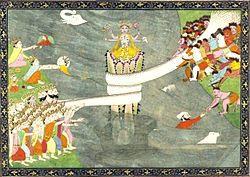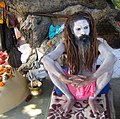Kumbh Mela
| Kumbh Mela | |
|---|---|
 2001 Kumbh Mela at Allahabad | |
| Type | Spring festival of Goddess Gauri |
| Celebrations | every 12 years at 4 locations |
| Begins | Puasa Purnima |
| Ends | Magh Purnima |
Kumbh Mela (Devanagari: कुम्भ मेला) is a mass Hindu pilgrimage. It occurs four times every twelve years and rotates among four locations: Allahabad (Prayag) at the confluence of Ganga and Yamuna and mythical Saraswati river, Haridwar along Ganga river, Ujjain along the Kshipra river and Nashik along the Godavari river, so a Kumbh Mela is practically held every three years across the four locations.
The Ardh Kumbh Mela is celebrated every six years at Haridwar and Allahabad [1], while the Purna (complete) Kumbh always takes place at Allahabad every twelve years [2]. Over 45 days beginning in January 2007, more than 70 million Hindu pilgrims took part in the Ardh Kumbh Mela at Allahabad, and on January 15, the most auspicious day of the festival of Makar Sankranti, more than 5 million participated [3].
The Maha Kumbh Mela ('Great' Kumbh Mela) which comes after 12 'Purna Kumbh Melas' which is after every 144 years is also held at Allahabad [4][5][2]. The 2001, Maha Kumbh Mela was attended around 60 million people, making it the largest gathering anywhere in the world [6][7][8].
Timing
According to Indian astrology, it is celebrated when the planet of Brihaspati (Jupiter) moves into the zodiac sign of Aquarius or Kumbha [9][10]. Each sites celebration dates are calculated in advance according to a special combination of zodiacal positions of Sun, Moon, and Jupiter [11].
Etymology
Kumbha is a Sanskrit word for Pitcher, sometimes referred as the Kalasha, it also a zodiac sign in Indian astrology for Aquarius, the sign under which the festival is celebrated, while Mela means 'a gathering' or 'a meet', or simply a fair.
History

The observance of Kumbh Mela dates back many centuries in Ancient India, to the Vedic period, where the river festivals first started getting organised. In Hindu mythology, its origin is found the one of the popular creation myths and the Hindu theories on evolution, the Samudra manthan episode (Churning of the ocean of milk), which finds mention in the Srimad Bhagavatam, Vishnu Purana, the Mahabharata and the Ramayana [12].
The Gods had lost their strength, and to regain it, they thought of churning the Ksheera Sagara (primordial ocean of milk) for amrit (the nectar of immortality), this required them to make a temporary agreement with their arch enemies, the demons or Asuras to work together, with a promise of sharing the nectar equally thereafter [13]. However, when the Kumbha (urn) containing the amrita appeared, a fight ensued. For twelve days and twelve nights (equivalent to twelve human years) the gods and demons fought in the sky for the pot of amrita. It is believed that during the battle, the celestial bird, Garuda the vehicle of Vishnu flew away with the Kumbha of elixir, and that is when drops of amrita fell at four places on earth: Prayag, Haridwar, Ujjain and Nashik, and that is where the Kumbh Mela is observed every twelve years [14].
First written evidence of the Kumbha Mela can be found in the accounts of Chinese traveller, Huan Tsang or Xuanzang (602 - 664 A.D.) who visited India in 629 -645 CE, during the reign of King Harshavardhana [15][16][17] According to The Imperial Gazetteer of India, an outbreak of cholera occurred at the 1892 Mela at Haridwar, which lead to the rapid improvement of arrangement by the authorities and the formation of Haridwar Improvement Society, and in 1903 about 400,000 people attended the fair [10]. During the 1954 Kumbh Mela stampede at Allahabad, around 500 people were killed, and scores were injured. Ten million people gathered at Haridwar for the Kumbh on April 14, 1998 [15].
The 1998 Kumbh Mela saw over 10 million pilgrims visiting Allahabad, to take a dip in the holy river, Ganga [18]. Around 1 million people from around the world participated in the 'Maha Kumbh Mela' at Prayag (Allahabad) in 2001, with with planetary positions that repeat only once in 114 years [19].
The Ritual


Kumbh Mela is attended by millions of people on a single day. The major event of the festival is a ritual bath at the banks of the rivers in each town. Other activities include religious discussions, devotional singing, mass feeding of holy men and women and the poor, and religious assemblies where doctrines are debated and standardized.
Kumbh Mela (especially the Maha Kumbh Mela) is the most sacred of all the pilgrimages. Thousands of holy men and women (monks, saints and sadhus) attend, and the auspiciousness of the festival is in part attributable to this. The sadhus are seen clad in saffron sheets with plenty of ashes and powder dabbed on their skin per the requirements of ancient traditions. Some called nanga sanyasis or 'Digambars (sky-clad)' may often be seen without any clothes even in severe winter, generally considered to live an extreme lifestyle. This tends to attract a lot of western attention as it is seemingly in contrast to a generally conservative social modesty practised in the country.
After visiting the Kumbh Mela of 1895, Mark Twain wrote:
It is wonderful, the power of a faith like that, that can make multitudes upon multitudes of the old and weak and the young and frail enter without hesitation or complaint upon such incredible journeys and endure the resultant miseries without repining. It is done in love, or it is done in fear; I do not know which it is. No matter what the impulse is, the act born of it is beyond imagination, marvelous to our kind of people, the cold whites.[20]
Recent Kumbh Melas
1894

According to Paramahansa Yogananda in his work the Autobiography of a Yogi, it was on the Kumbha Mela in January 1894 at Allahabad that his Guru Sri Yukteswar met Mahavatar Babaji for the first time. [21].
2003
When the Kumbh Mela was held in Nashik, India, from July 27 to September 7 2003, 39 pilgrims (28 women and 11 men) were trampled to death and 57 were injured (keeping in mind that the number of devotees attending the fair was around 70 million). Devotees had gathered on the banks of the Godavari river for the maha snaan or holy bath. Over 30,000 pilgrims were being held back by barricades in a narrow street leading to the Ramkund, a holy spot, so the sadhus could take the first ceremonial bath. Reportedly, a sadhu threw some silver coins into the crowd and the subsequent scramble led to the stampede.[22][23]
2007
Every six years there is an Ardh Kumbh Mela at Prayag (also known as Allahabad). The actual dates are dependent on stellar constellations and were announced as below:
- Important bathing dates
- 3 Jan (Paush Purnima)
- 14 Jan (Makar Sankranti)
- 19 Jan (Mauni Amavasya)
- 23 Jan (Basant Panchami)
- 2 Feb (Magh Purnima)
Upcoming Kumbh Mela
Haridwar Ardha Kumbh Mela 2010 (March-April)
- Haridwar (the gateway to God) will host the Ardha Kumbha mela in the year 2010
- Allahabad (Prayag) Maha Kumbh Mela 2013 (January 27th to February 25th)
- The Maha Kumbha Mela will again be held at Allahabad (Prayag) in the year 2013.
- Nasik Maha Kumbh Mela 2015 (August 15th to September 13th)
- Nasik will host the Maha Kumbha Mela in 2015
- Ujjan Maha Kumbh Mela 2016 (April 22nd to May 21st)
Kumbh Mela in Media
Amrita Kumbher Sandhane, a 1982 Bengali feature film directed by Dilip Roy, documents the Kumbh Mela. Kumbha Mela has been theme for many a documentaries, including "Kumbh Mela: The Greatest Show on Earth" (2001) by [24], Short Cut to Nirvana (2004), by Maurizio Benazzo and Nick Day [25][26], Kumbh Mela: Songs of the River (2004), by Nadeem Uddin[27], and Invocation, Kumbha Mela (2008) [28]
Documentaries online
Gallery
-
The Triveni Sangam, or the intersection of Yamuna River and Ganges River and the mythical Saraswati River, where devotees perform rituals.
See also
Further reading
- Kumbha Mela: History and Religion, Astronomy and Cosmobiology, by Subas Rai. Published by Ganga Kaveri Pub. House, 1993. ISBN 818569401X.
- The Kumbh Mela, by Mark Tully (Author), Richard Lannoy (Photographer), Ashok Mahendra (Photographer). Indica Books. 2002. ISBN 8186569227.
- Kumbha Mela, by Jack Hebner. Published by Transition Vendor, 2003. ISBN 1886069905.
- Nashik Kumbh Mela: A Spiritual Sojourn, by Govind Swarup. India Book House Ltd, 2006. ISBN 8175083794.
- Pilgrimage and Power: The Kumbh Mela in Allahabad, 1765-1954, by Kama Maclean. Oxford University Press, USA. 2008. ISBN 0195338944.
Notes
- ^ The Urn Festival TIME, Feb 08, 1960.
- ^ a b Kumbh Mela The Basis of Civilization--water Science?: Water Science?, by J. C. Rodda, Lucio Ubertini, International Association of Hydrological Sciences, IAHS International Commission on Water Resources Systems, Consiglio nazionale delle ricerche (Italy). Published by International Association of Hydrological Science, 2004. ISBN 1901502570 Page 165.
- ^ Millions of Hindus Wash Away Their Sins Washington Post, January 15, 2007.
- ^ The Maha Kumbh Mela 2001 indianembassy.org.
- ^ Kumbh Mela dates kumbhamela.net.
- ^ Millions bathe at Hindu festival BBC News, January 3, 2007.
- ^ Kumbh Mela pictured from space - probably the largest human gathering in history BBC News, January 26, 2001.
- ^ Kumbh Mela: the largest pilgrimage - Pictures: Kumbh Mela by Karoki Lewis The Times, March 22, 2008.
- ^ Kumbha Mela Students' Britannica India, by Dale Hoiberg, Indu Ramchandani. Published by Popular Prakashan, 2000. ISBN 0852297602.Page 259-260.
- ^ a b Haridwar The Imperial Gazetteer of India, 1909, v. 13, p. 52.
- ^ Kumbh Mela 'Britannica.com.
- ^ Ramayana, Book I; Canto: XLV - The Quest for the Amrit Ramayana of Valmiki.
- ^ The Holiest Day in History TIME, Jan 31, 1977.
- ^ Urn Festival TIME, May 1, 1950.
- ^ a b Kumbh Mela - Timeline What Is Hinduism?: Modern Adventures Into a Profound Global Faith, by Editors of Hinduism Today, Hinduism Today Magazine Editors. Published by Himalayan Academy Publications, 2007. ISBN 1934145009. 242-243.
- ^ Kumbh Mela www.archaeologyonline.net.
- ^ Kumbh Mela Channel 4.
- ^ Kumbh Mela, a study Missouri State University
- ^ Maha Kumbh Mela concludes The Hindu, February 22, 2001.
- ^ Mark Twain, "Following the Equator: A journey around the world"
- ^ Autobiography of a Yogi by Paramahansa Yogananda Chapter 36 Autobiography of a Yogi by Paramahansa Yogananda, wikisource.
- ^ 39 killed in Kumbh Mela stampede The Hindu, Aug 28, 2003
- ^ Holy man's gift blamed for 39 dead in stampede The Guardian, August 28, 2003.
- ^ Kumbh Mela: The Greatest Show on Earth at IMDb
- ^ Short Cut to Nirvana at IMDb
- ^ Mela films
- ^ Kumbh Mela: Songs of the River at IMDb
- ^ Invocation, Kumbha Mela at IMDb
External links
- A Kumbh Website.
- Information on Ardh Kumbh Mela 2007.
- Ardh Kumbh Mela 2007
- Gods, Gurus and the Ganges
- Time line of Kumbha mela
- Photo Essays


